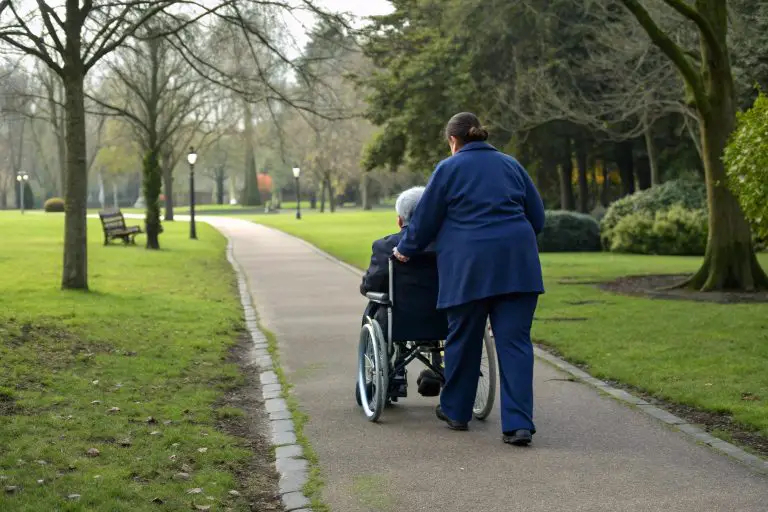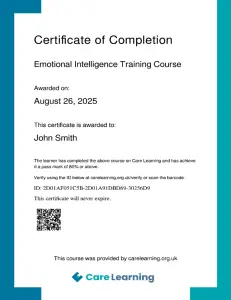Seasonal Affective Disorder (SAD) is more than just the “winter blues.” It’s a form of depression that follows a seasonal pattern — often worsening during the shorter, darker months. Left unrecognised, SAD can affect mood, energy levels, relationships, and overall wellbeing.
This Seasonal Affective Disorder (SAD) online course helps health and social care professionals understand the causes, symptoms, and management of SAD. You’ll learn how to recognise signs early, support individuals affected by seasonal mood changes, and promote positive coping strategies.
Why Take This eLearning Course?
Millions of people across the UK experience low mood and fatigue during the winter months — but for some, these symptoms become debilitating. By understanding Seasonal Affective Disorder, you can make a meaningful difference in identifying, supporting, and managing those affected.
This course is ideal for anyone working in health, social care, or wellbeing roles who wants to deepen their understanding of mental health conditions that fluctuate with the seasons.
You’ll gain practical knowledge to:
- Recognise the key symptoms and patterns of Seasonal Affective Disorder.
- Understand the biological and environmental factors contributing to SAD.
- Support individuals through evidence-based treatments like light therapy and CBT.
- Encourage healthy lifestyle habits to reduce the impact of SAD.
- Promote empathy and awareness around this often misunderstood condition.
Seasonal Affective Disorder Awareness Training Course Outline
Module 1: Understanding Seasonal Affective Disorder (SAD)
Learners will gain an overview of Seasonal Affective Disorder (SAD), a type of depression that follows a seasonal pattern—most commonly occurring during autumn and winter. The module explains common symptoms, including low mood, fatigue, and changes in sleep or appetite, as well as potential causes such as reduced sunlight exposure and neurotransmitter imbalance.
Module 2: Patterns and Impact of SAD
This module explores the seasonal patterns of SAD, including the more common winter-onset and the less frequent summer-onset form. Learners will examine how SAD affects individuals physically, emotionally, and socially—impacting energy, concentration, relationships, and productivity. The module highlights how understanding these patterns can help support individuals in maintaining wellbeing throughout the year.
Module 3: Assessment and Diagnosis
Learners will understand how Seasonal Affective Disorder is clinically assessed and diagnosed. The module covers assessment processes that include mood, lifestyle, and sleep evaluation, as well as recognised diagnostic criteria. Learners will explore the role of healthcare professionals in identifying and supporting those affected and complete a short knowledge check to consolidate learning.
Module 4: Treatment Options
This module introduces a range of treatment approaches for managing SAD. Learners will explore lifestyle measures such as increasing exposure to daylight and maintaining regular exercise routines, alongside light therapy and talking therapies (including Cognitive Behavioural Therapy).
Module 5: Practical Strategies for Managing SAD
Learners will develop practical skills to support themselves or others experiencing SAD. The module provides guidance on establishing a positive winter routine, maintaining social connections, and improving nutrition and physical activity to stabilise mood and energy. It also challenges common misconceptions and stigma surrounding SAD, helping learners foster empathy and understanding in both professional and personal contexts.
Module 6: Case Studies and Real-Life Examples
This module uses real-life examples and case studies to demonstrate how SAD presents in different individuals. Learners will explore the diverse challenges faced and how evidence-based strategies are applied in real-world scenarios. Through reflection and discussion, learners will identify good practice and potential areas for improvement in supporting people with SAD. A short knowledge check reinforces understanding.
Module 7: Support and Resources
In the final module, learners will discover a range of self-help tools and professional resources to support ongoing wellbeing. Topics include reframing thoughts about winter, using daily light exposure to maintain circadian rhythm, and knowing when and where to seek help.
Learning Outcomes
By the end of this course, you will be able to:
- Define Seasonal Affective Disorder (SAD) and explain its seasonal pattern.
- Recognise the common symptoms, including low mood, lethargy, and appetite changes.
- Understand potential causes, including reduced sunlight exposure and neurotransmitter imbalances.
- Identify risk factors, such as genetics and environmental influences.
- Describe how SAD is assessed and diagnosed using recognised standards like DSM-IV and ICD-10.
- Understand treatment options, including lifestyle interventions, light therapy, talking therapies, and medication.
- Apply practical strategies to support people with SAD, such as developing routines, encouraging social interaction, and promoting exercise.
- Address common myths and stigma associated with SAD.
- Use real-life examples and case studies to reinforce understanding.
- Signpost to reliable mental health resources and support organisations.
Target Audience
This course is suitable for:
- Health and social care workers supporting people with mental health challenges.
- Support workers, managers, and team leaders in residential or community settings.
- Wellbeing and mental health professionals wanting to enhance seasonal awareness.
- Anyone interested in understanding the link between seasons, light, and mood.
No prior experience or qualifications are needed — the course is designed for learners at all levels.
FAQ
How long does the course take?
The course takes around 1 hour to complete, depending on your pace and reflection time.
Is this course CPD certified?
This course will be accredited shortly.
Is it relevant for non-clinical staff?
Absolutely. The course is suitable for all roles within health and social care, including non-clinical and support staff.
Will I receive a certificate?
Yes, you’ll receive a Care Learning Certificate of Completion at the end of the course.
SAD can have a profound impact on quality of life, relationships, and productivity. By raising awareness and understanding the condition, you can help identify those at risk, promote effective coping strategies, and challenge the stigma surrounding seasonal depression.
Health and social care professionals play a vital role in promoting mental wellbeing throughout the year — and that starts with understanding the seasonal factors that affect mood and energy.
Enrol on the Seasonal Affective Disorder (SAD) Training Course today
Gain the knowledge and confidence to recognise and support individuals affected by seasonal mood changes — and help make every season one of wellbeing and hope.
You must log in and have started this course to submit a review.






